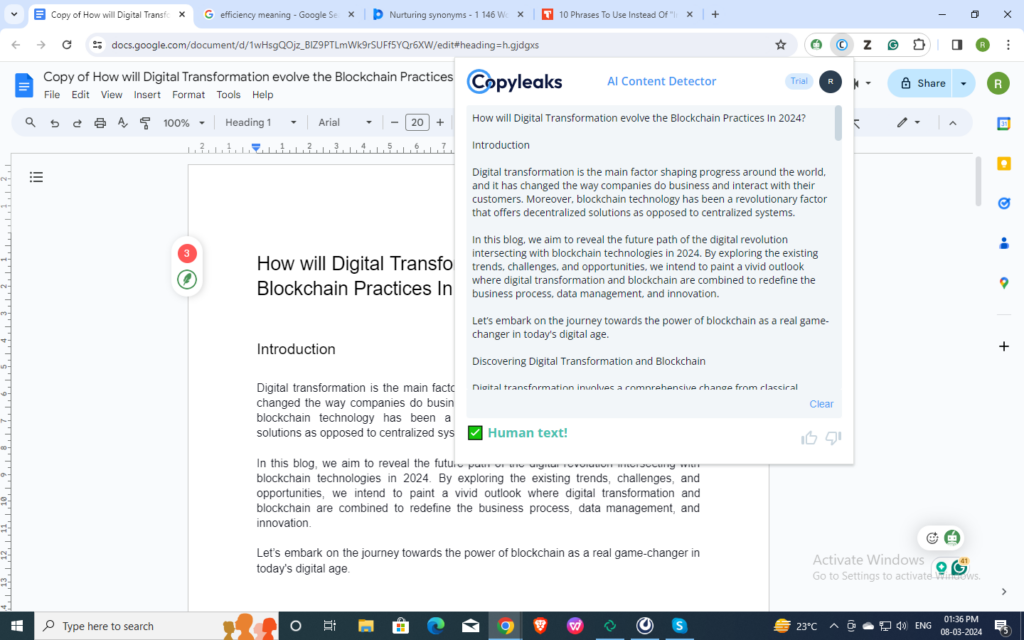How will Digital Transformation evolve the Blockchain Practices In 2024?

Introduction
Digital transformation is the main factor shaping progress around the world, and it has changed the way companies do business and interact with their customers. Moreover, blockchain technology has been a revolutionary factor that offers decentralized solutions as opposed to centralized systems.
In this blog, we aim to reveal the future path of the digital revolution intersecting with blockchain technologies in 2024. By exploring the existing trends, challenges, and opportunities, we intend to paint a vivid outlook where digital transformation and blockchain are combined to redefine the business process, data management, and innovation.
Let’s embark on the journey towards the power of blockchain as a real game-changer in today’s digital age.
Discovering Digital Transformation and Blockchain
Digital transformation involves a comprehensive change from classical, traditional procedures to the utilization of digital technologies in every aspect of business operations, particularly as a fundamental means of delivering value to customers.
By integrating these innovative technologies into their processes, organizations can achieve efficiencies in operations, digitalize data collection, and ultimately improve customer experiences.
Nowadays, as the business world becomes increasingly dynamic, digital transformation is no longer a choice but a demand for those companies that are trying to keep pace with the changing trends. Cryptocurrency is a digital form of cash; similarly, blockchains are electronic ledger systems that store information about all transactions without going through a third party.
It operates on a peer-to-peer network of computers in a decentralized manner to provide data immutability, transparency, and cryptographic security. Each block of the blockchain contains a cryptographic code from the previous block, thus forming a chain that cannot be retroactively changed.
Blockchain represents a desirable opportunity for applications in which trust, transparency, and resilience against every adaptation of data are essential.
Blockchain achievement seems to be higher, but there are challenges, including scalability, interoperability, and regulatory concerns, that hinder blockchain uptake. While many other industries keep expanding on blockchain-based solutions, large-scale implementation is, however, hampered by these barriers.
Nonetheless, the digital revolution has affected industries during which the usefulness of blockchain is anticipated to transform, the challenges to be addressed, and other opportunities for inventiveness and disruption to be embraced.
Now that we are thoroughly versed in the concepts of digital transformation and blockchain, let’s look into the factors that bring them to light.
Key Trends Driving Digital Transformation in 2024
1. Artificial Intelligence (AI) and Machine Learning (ML):
AI and ML are at the core of digital transformation as they enable cognitive automation, predictive analytics, and personalized customer experiences.
Companies use AI-powered algorithms to work through big data to locate important insights and automate decision-making. This not only increases operational efficiency but also enables faster innovation, which allows them to be more responsive and deliver more targeted products and services to customers.
2. Internet of Things (IoT):
Business operations are on the path of evolution because of IoT devices that transmit real-time data from connected sensors, devices, and machines, capturing various parameters.
This data facilitates IoT predictive maintenance as well as analysis and process optimization, thus resulting in booming productivity, reduced downtime, and superior asset utilization.
Organizations can therefore create different ways of generating income, improving customer experiences, and practicing innovation, among other sectors, through IoT-driven insights.
3. Cloud Computing:
Cloud computing is a fundamental underpinning for digital transformation, offering elastic, flexible, and cost-effective infrastructure and service options.
Companies use this platform to deliver applications, store data, and do analytics, as well as by the effective remote teams working together across the network.
Cloud-native technologies foster quick creation as well as the deployment of new solutions that help the business respond to market shifts and increase operation effectiveness.
4. Big Data Analytics:
Big data analytics forms the backbone of digital transformation by letting organizations derive actionable information from enormous and varied data sets.
Usage of the advanced techniques of data analytics, for example, predictive modeling, data visualization, and real-time analytics, allows businesses to make informed decisions, streamline the process, and identify ways they can further develop.
Using big data as one of the potential fuels, companies gain a leading position in the market, enhancing service quality and filling in innovative gaps, affecting industries positively.
5. Cybersecurity and Data Privacy:
The digital ecosystem is evolving, and so is the paradigm risk. This is increasing the focus on cybersecurity and data privacy.
Data breaches, ransomware attacks, and conformity to regulations are the major ascents intensifying with the evolution of digital transformation.
Firms that are involved in thorough cyber security programming are vigorously employing automation in their systems to shield themselves against any cyber threats.
To secure the customers’ data and cover the company’s digital assets, they deploy tools like threat detection mechanisms that are AI-driven, code encryption, and identity management.
Additionally, strict adherence to GDPR and CCPA-related data privacy regulations is critical for maintaining customers’ trust and avoiding the legal risk that is imposed by the digital era.
Future Outlook: Digital Transformation and Blockchain in 2024
Blockchain technologies are expanding all horizons worldwide, breaking all previous records.
Advancements in the sectors of interoperability, ability to grow as and when needed, and adherence to regulatory compliances shall be the target for future evolution, motivation to innovation, and adaptation.
Interoperability will aid in performing the exchange of data between multiple blockchains quite easily, in order to foster collaboration and integration.
With time a company is likely to expand. Under such circumstances, the scalability feature of blockchain comes into existence. Its 2nd layer protocol deals with expandability, paving the way for operations handling massive applications.
Additionally, there will be an emphasis on the enhancement of eco-friendly blockchain systems to shave down on the amount of electricity used, thus accomplishing sustainable goals.
The emerging technologies of Web3, DeFi (Decentralized Finance), NFT (Non-Fungible Token), and BaaS (Blockchain-as-a-Service) platforms will be some of the key tools that will possibly determine the direction or route of blockchain in the future.
Blockchain is a technology that holds immense importance in every company regardless of their domain. It helps in enhancing security, clarity, characteristics, and effectiveness to grab the maximum from procedures, minimize production costs, and generate revenue options.
In summary
Long story short, considering the year 2024, the digital transformation world shaking hands with blockchain technology will lead to significant innovations and opportunities. With businesses transforming themselves into digitalization, blockchain will keep unfolding to maintain pace with the growing demand of today’s economy.
With the ability to communicate across all platforms, being flexible enough to grow at all times, withstand all storms, and comply with the forefront regularly, shall have businesses restructure. This will lead to skyrocketing transparency, producing more outcomes with the least resources, and most important, create a sense of reliance in the field of digital economy.






